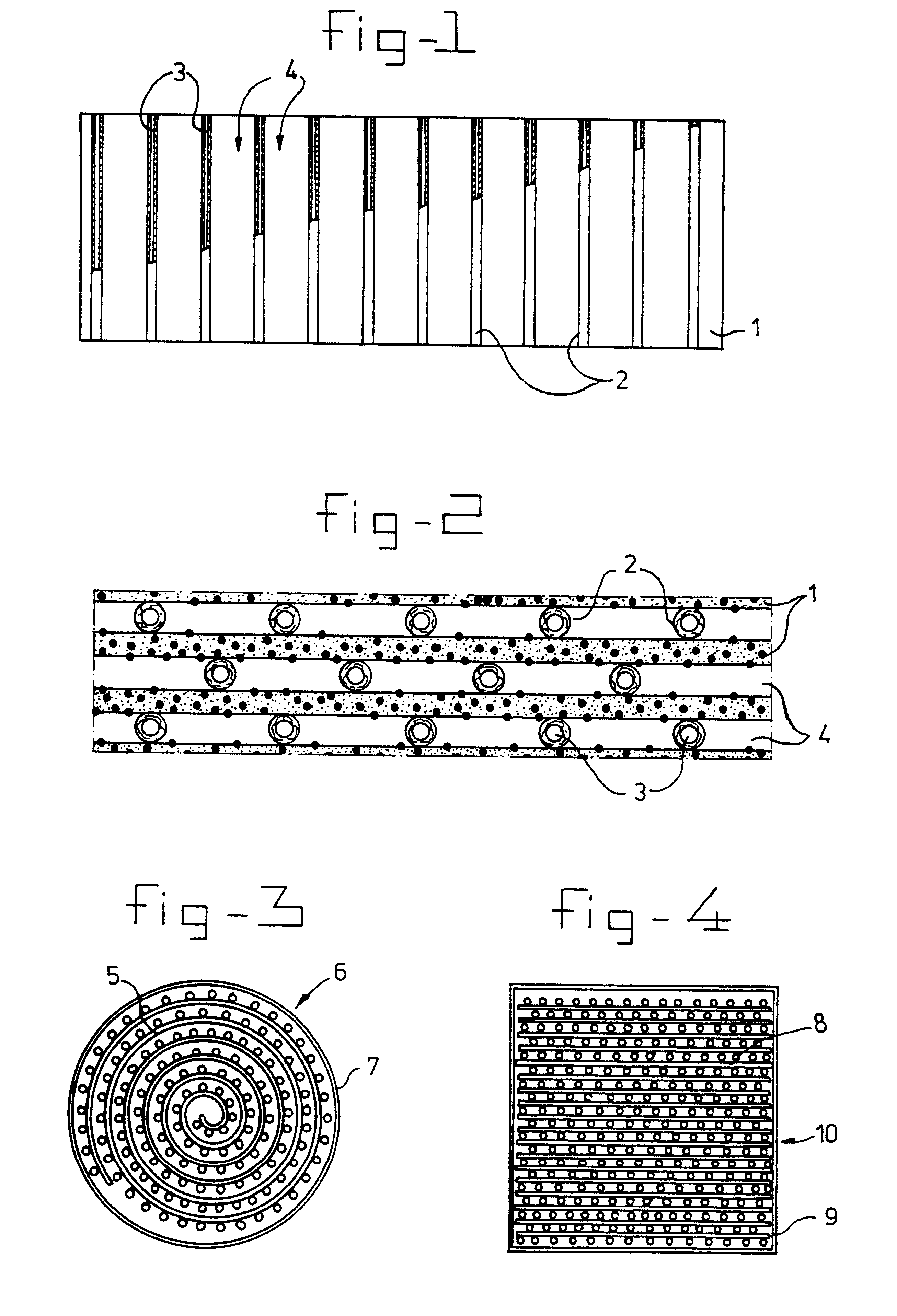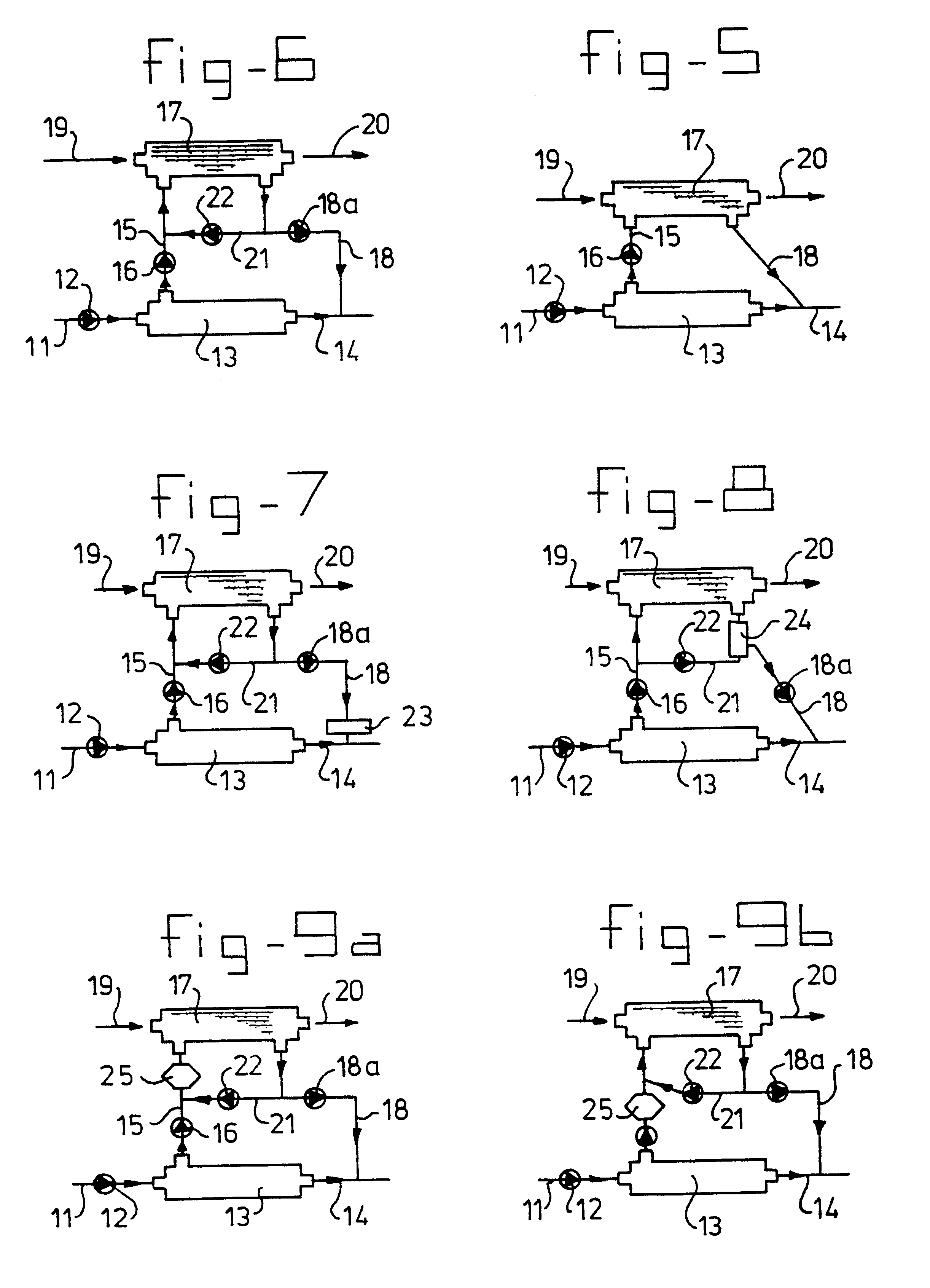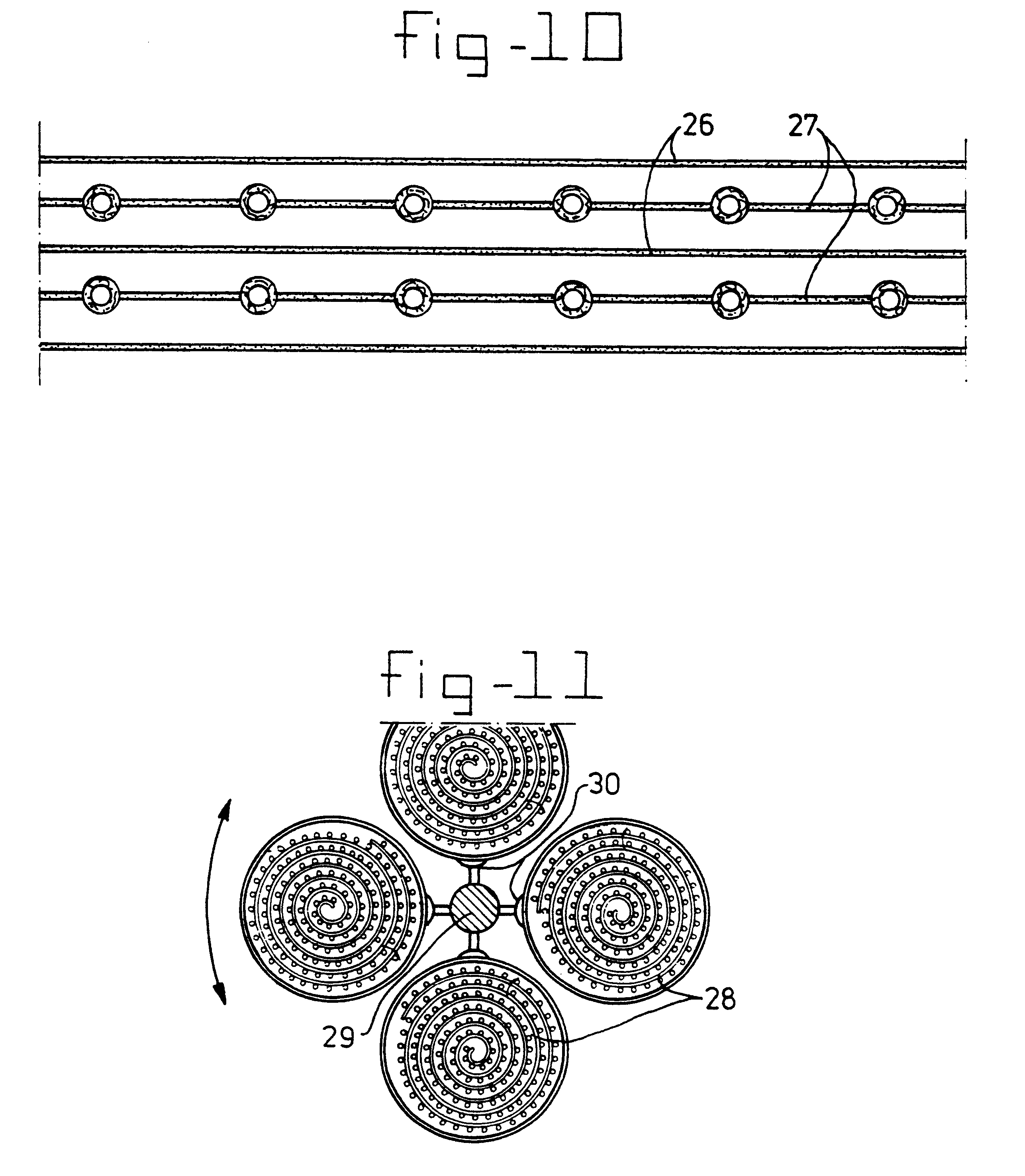A special problem in the cultivation of adherent cells--compared to the cultivation of cells in suspension or in confluent
layers--is to provide sufficient nutrients and / or
oxygen to the cells and / or provide for sufficient removal of waste products and / or
carbon dioxide.
This is especially a problem with cells that put stringent demands on both
oxygenation as well as the removal of waste products, such as liver cells.
The non-availability of suitable solid supports and methods for the
in vitro cultivation of liver cells has over the last 40 years severely hindered the development of the so-called bio-
artificial liver (BAL) systems, systems that could be used in patients with liver defects for the support and / or replacement of the natural
liver function.
However, due to the abovementioned lack of suitable methods and / or materials for cultivating and / or maintaining liver cells
in vitro, the bio-
artificial liver systems from the prior art have so far proved insufficient, because they do not fully replace all the functions carried out by the liver of the patient
in vivo, because they have insufficient capacity, and / or because the time during which they are therapeutically effective is too limited for practical use.
All these systems have been found to be insufficient.
The disadvantages of bio-artificial liver systems include ( .
. . ) the problem of maintaining normal
hepatocyte viability and function at the
high cell density necessary for clinical application.
However, the prior art
hepatocyte systems also suffer from problems with regard to capacity and effective working time, see Sussman and Kelly:
. . ) the technology has severe limitations.
Coupled with the labour-intensive nature of
cell preparation, this makes it almost impossible to scale up production to meet current needs in a cost-effective manner.
Moreover, freshly isolated cells do not appear to last very long during treatment.
A liver assist device that lasts for only 6 to 7 hours, as some have been reported to do, clearly falls short of allowing
liver regeneration.
Finally, production of any such device using animal cells entails a number of problems, especially in areas of
sterility and lot-to-lot variability.
However, a serious drawback of this
system, besides the complexity of constructing and using a 200 glass plate-reactor, is that the
monolayer culture of hepatocytes on said plates precludes the advantageous formation of
hepatocyte aggregates.
Because of these limitations said hollow
fiber reactor cannot easily be scaled up to a capacity required for practical therapeutic application.
Furthermore, this reactor is used with a very "
closed path" column with a
high density of the microcarriers, which leads to the formation of
microcarrier pellets and to
mass transfer problems with regard to the cells at the center of such a pellet.
Another
disadvantage of this system is that the hepatocytes first have to be immobilized on the micro-carrier before the hepatocytes can be introduced into the hollow
fiber reactor.
This involves further complicating
processing steps that can lead to loss of cell viability.
Furthermore,
perfusion with
whole blood can lead to the fibers and / or the pores thereof within the
bioreactor getting clogged, which problem could only be solved by totally replacing the hollow fiber module, requiring a fresh isolation / immobilization of the hepatocytes.
Other disadvantages of this and other hollow fiber systems using
whole blood as the
liquid medium are that "the
hollow fiber membrane must first act as a
plasma separator before any significant transport of nutrients and metabolites can take place across the fiber wall", and that it "requires systemic anticoagulation with
heparin to prevent clotting in the module".
However, with regard to activity and function, the use of such tumor-derived cell lines is generally less preferred in the art than the use of isolated primary hepatocytes, also from a safety standpoint.
Furthermore, the C3A cell line used by Sussman lacks some very important functions of primary hepatocytes.
However, this system also requires a complicated and
time consuming pre-immobilization of the hepatocytes.
In order to obtain sufficient attachment of the cells, the surfaces of the fibers must first be coated with a proteineous
basement membrane product, such as
Matrigel.RTM. or other collagen-based materials, requiring a separate and expensive pretreatment step.
Even so, as hollow fibers are not specifically designed and / or suited for use as a solid support in cell cultivation, the attachment and the speed thereof permitted by and / or obtainable with said reactors is limited and heavy inoculum charges are required when seeding the reactor.
Again, these large aggregates can lead to
mass transfer problems with regard to the cells in the center of said aggregate.
Also, it is well known that hollow fibers are difficult to process, and in this respect the manufacture of the very complicated three-dimensional
fiber network described by Gerlach et al., comprising four separate discrete capillary systems, suffers from a
disadvantage from an economical point of view.
Also, this reactor is complicated to operate, requiring multiple separated inlet / outlet control systems.
A general problem of all the abovementioned hollow fiber bioreactors of the prior art is that the
liquid medium (blood,
plasma) to be treated is separated from the hepatocytes by the
hollow fiber membrane; in other words, that there is no direct contact between the
liquid medium and the hepatocytes in the reactor.
The passage through the membrane can lead to transport phenomena that can limit the achievable
mass transfer, and therefore the efficiency of the BAL-system.
Also, the membranes can get clogged, especially when
perfusion with whole blood is used.
In that case the BAL system or parts thereof have to be replaced, which means that therapy has to be interrupted or even stopped.
However, these proteins are of comparable sizes to antibodies, which could have an
adverse effect when directed against nonautologous hepatocytes in the
bioreactor.
In many bioreactors this gives rise to the formation of non-physiological hepatocyte
pellets.
Hepatocytes in the center of these large aggregates show poor
metabolic activity and even possible
necrosis due to high gradients as a result of hindered transport of nutrients and
oxygen to and
carbon dioxide, toxins and cell products from these cells.
Besides, in most systems substrate exchange depends on
diffusion which further limits
mass transfer compared to the
in vivo situation where hepatocytes function under
perfusion conditions with low gradients.
Also, the bioreactors of the prior art are limited with respect to the amount of liquid medium that can be withdrawn from the hollow fiber lumen, as in general the fusion transport will be too slow.
Therefore, an active withdrawal of liquid medium from within the hollow fibers will be required, even so, the total flow through the
hollow fiber membrane will be very slow and / or lead to the undesired formation of gradients, even with a high flow of liquid medium through the hollow fibers themselves.
Another general problem with the bio-artificial liver systems of the prior art is that they require the use of liver cell preparations with a high viability (>80%) and a high attachment.
As already acknowledged by Sussman and Kelly hereinabove, the production of such cells is a very costly, complex and time-consuming process requiring isolation and subsequent cultivation of suitable liver cells in sufficient viability and quantity which involves complicated procedures that do not reliably afford the required results, even when carried out by qualified experts.
Furthermore, known hepatocyte-containing BAL-systems cannot be stored before use for a prolonged period of time because the viability and function of the liver cells in the reactor cannot be maintained at a therapeutically acceptable level.
Also, the only technique available for preserving isolated liver cells over a longer period of time, i.e.,
cryopreservation, does not afford cells that are suitable for use with known BAL-systems, see Rozga et al., mentioned hereinabove:
However, [
cryopreservation] may result in a significant loss of cell viability [.
Because of these problems, the known BAL-systems cannot be used as "
off the shelf" units that can be kept and / or maintained in hospitals until their use is required, as is the case with other
artificial systems for organ support such as for instance
dialysis machines or
artificial heart or
lung systems.
Also, replacement during therapy of a spent primary liver
cell based BAL system of the prior art with insufficient function with a fresh BAL system is usually not economically feasible over a prolonged period of time.
Better results have been obtained by using immortalized cells or the C3A cell line reported by Sussman et al., however, the use of this hepatoblast derived cell line has other disadvantages as already mentioned hereinabove.
This matrix material has some specific advantages over micro-capsules, which are costly and delicate to produce and give problems at
high cell density growth, because frequently cells at the center of the
capsule die.
Also, the microcapsules may burst prematurely losing their contents and each new
inoculation requires a fresh encapsulating procedure.
With microcarriers, these cells are immobilized on the outside of the carrier particles, making them susceptible to
shear stress and particle collisions, for instance during preparation or packing of the reactor.
In fact, the use of the "
spiral wound" reactor according to GB-A-2,178,447 for culturing and / or maintaining hepatocytes would in practice lead to insufficient
oxygenation, because the oxygen is supplied by means of just one conduit covering the entire length of the matrix mat.
The use of such a single conduit would lead to the generation of an undesired oxygen gradient along its length or even to local oxygen depletion, especially when the reactor is scaled up by increasing the number of matrix windings.
Furthermore, the use of a singular
spiral wound conduit for liquid transport can lead to an inhomogeneous supply of liquid medium to all the parts of the
bioreactor, for instance by the generation of undesired gradients.
It will be clear that this will make the 3D hollow
fiber network according to Gerlach et al. very difficult and expensive to produce.
Again, this was not possible with the prior art BAL-systems.
This embodiment will usually not be suited for liver cells that are unable to divide and grow after they have been isolated, such as primary liver cells.
This method of distributing the cells throughout the reactor prevents the formation of a
cell pellet at the bottom in the bioreactor, which would lead to
mass transfer problems during use, especially with regard to the cells at the center of the pellet, which can lead to loss of
functional activity and / or viability.
This favorable removal of dead cells cannot be achieved with the prior art hollow fiber bioreactors, because in these reactors, the liver cells essentially are present in an enclosed "compartment" between the hollow fibers, without means for perfusing said space, or captured within a (hydro)gel.
 Login to View More
Login to View More  Login to View More
Login to View More 


